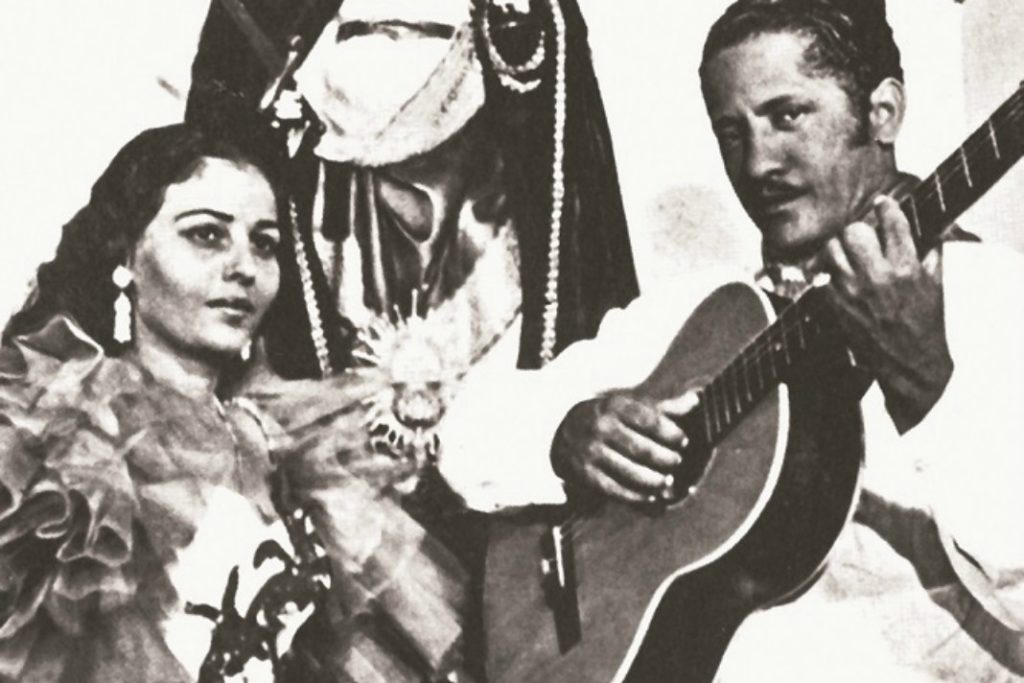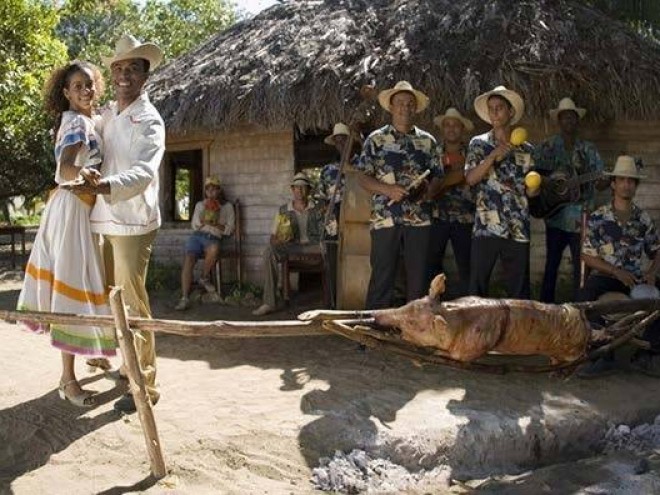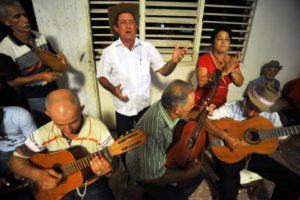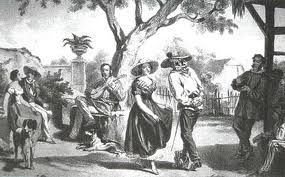DE NUESTRA DÉCIMA GUAJIRA Y “EL PUNTO” EN LA MÚSICA CUBANA. VIDEO.
Para algunos es, esencialmente, el llamado punto, la improvisación de los cantadores de ciertas zonas del campo cubano con las diversas tonadas con las que se cantan la décima. El punto es una manifestación de nuestra música popular muy cerca de lo puramente hispánico.
Al termino de la guerra de Independencia y la creación de la república como tal, nuestro país recibió muy intensamente, fuertes migraciones de las regiones más pobres de España. Canarios, gallegos, asturianos, llegaron en grandes oleadas.
Los canarios en especial, grandes conocedores del cultivo del tabaco, poblaron zonas del campo cubano: las tierras de la Vueltabajo y otras regiones del centro del país ―Tunas de Zaza, Manicaragua, Cabaiguán― en las que se dedicaron a la agricultura tabacalera.
Por supuesto que en las Islas Canarias y otras regiones española existían ricas tradiciones musicales de carácter folclórico y tradicional, que iban pasado oralmente de padres a hijos.
La décima es una estrofa culta: varios poetas españoles la usaron en diversas estructuras, pero es el músico y poeta rondeño Vicente Espinel quien establece su forma definitiva, con la que se le conoce hoy en el mundo.
SURGE EN CUBA.
En Cuba, la décima se establece desde inicios del siglo XIX. Es el poeta Francisco Pobeda y Armenteros, conocido como El trovador cubano el que la usa por primera vez como instrumento de la poesía criollista. Pero es Juan Cristóbal Nápoles Fajardo, El Cucalambé, quien la fija como estrofa de la poesía campesina.
La décima cucalambeana combina y casi funde la estampa del guajiro cubano con el entorno natural de la Isla. Los improvisadores del llamado “punto cubano” tienen su innegable maestro en el poeta tunero que, entre nosotros, convirtió en popular y hasta en instrumento del folclore a la culta décima barroca que Vicente Espinel había establecido en España.
El punto cubano tiene diversas tonadas con las que se cantan las décimas. Acaso lo más importante en él no sea la música con la que se canta la estrofa porque, en verdad, las tonadas se repiten y la verdadera novedad está en el texto de la décima que se acompaña con la tonada. Seguramente por ello a los cantadores del punto no se les llama así, sino poetas, porque lo habitual es que la décima sea improvisada y por ello, obra de quien la cante.
Es quizá por ello que no se grabe habitualmente la música campesina. La necesidad de preservarla no estaría en la originalidad de las tonadas ―que no son originales― sino en el talento improvisador del poeta, y en su calidad para sacar el máximo partido a su condición de cantador.
La tonada del punto campesino tiene al menos dos modos de cantarse: el punto fijo, en la que el poeta que canta su décima sigue estrictamente los patrones de tiempo y compás que el acompañamiento de las cuerdas le impone, y el punto libre, en el que la tonada casi se independiza del acompañamiento. Pueden afianzarse uno y otro por regiones. En el campo habanero (lo que hoy son las provincias de Artemisa y Mayabeque), por ejemplo, domina el punto libre.
Porque también nuestra música campesina se distingue por regiones, porque cada una de ellas tiene sus tonadas preferidas: hay un punto pinareño, uno espirituano, uno camagüeyano. Existen tonadas específicas, como la llamada tonada Carvajal en la que era un maestro, el ya desaparecido poeta cienfueguero, Luis Gómez.
En el Oriente sur, las actuales provincias de Granma, Santiago de Cuba y Guantánamo, las más mestizas de Cuba, prácticamente no hay punto guajiro.
El negro y el mulato cubanos pueden cantar punto, con las típicas tonadas que el punto usa, pero preferentemente no cantan esas tonadas, sino que prefieren construir, mejor que punto guajiro, sones montunos. Y pueden usar las décimas en ese género donde se hacen visibles las raíces musicales africanas.
Y asi termino por hoy mi somero resumen del siempre eterno y nacionalmente popular, la música y el punto guajiro y su compromiso nacional enraizada en la médula de la cultura nacional cubana.
ABOUT OUR “DECIMA GUAJIRA” AND “EL PUNTO” IN THE CUBAN MUSIC. VIDEO.
For some it is, essentially, the so-called ‘el punto’, the improvisation of the singers of certain areas of the Cuban countryside with the different tunes with which the tenth is sung. The point is a manifestation of our popular music very close to the purely Hispanic.
At the end of the War of Independence and the creation of the republic as such, our country received very strong, strong migrations from the poorest regions of Spain. Canaries, Galicians, Asturians, arrived in great waves.
The Canarios, especially those who know tobacco growing, populated areas of the Cuban countryside: the lands of the Vueltabajo and other regions in the center of the country – Tunas de Zaza, Manicaragua, Cabaiguán – in which they dedicated themselves to tobacco farming.
Of course, in the Canary Islands and other Spanish regions there existed rich musical traditions of folkloric and traditional character, which were passed orally from parents to children.
The tenth is a cultured stanza: several Spanish poets used it in different structures, but it is the Vicente musician and poet Vicente Espinel who establishes his definitive form, with which he is known today in the world.
SURGE IN CUBA.
In Cuba, the tenth is established since the beginning of the nineteenth century. It is the poet Francisco Pobeda and Armenteros, known as El trovador cubano who uses it for the first time as an instrument of Criollista poetry. But it is Juan Cristóbal Nápoles Fajardo, El Cucalambé, who fixes it as a stanza of peasant poetry.
The Tenth Cucalambeana combines and almost melts the stamp of the Cuban peasant with the natural environment of the Island. The improvisers of the so-called “Cuban point” have their undeniable master in the poet from Las Tunas who, among us, has become popular and even an instrument of folklore to the cultured tenth baroque that Vicente Espinel had established in Spain.
The Cuban point has different tunes with which the tenths are sung. Perhaps the most important thing in it is not the music with which the verse is sung because, in truth, the tunes are repeated and the real novelty is in the text of the tenth that is accompanied by the tune. Surely for that reason the singers of the point are not called like that, but poets, because the habitual thing is that the tenth one is improvised and therefore, the work of whoever sings it.
It is perhaps for this reason that peasant music is not usually recorded. The need to preserve it would not be in the originality of the tunes -which are not original- but in the improvising talent of the poet, and in his quality to make the most of his condition as a singer.
The tune of the peasant point has at least two ways of singing: the fixed point, in which the poet who sings his tenth strictly follows the time and beat patterns that the accompaniment of the strings imposes on him, and the free point, in the that the tune almost becomes independent of the accompaniment. They can strengthen each other by regions. In the Havana countryside (what are now the provinces of Artemisa and Mayabeque), for example, dominates the free point.
Because our peasant music is also distinguished by regions, because each one of them has its favorite tunes: there is a point from Pinar del Rio, one from Sancti Spiritus, one from Camagüey. There are specific tunes, such as the so-called tonada Carvajal in which he was a teacher, the now defunct Cienfuegos poet, Luis Gómez.
In the South East, the current provinces of Granma, Santiago de Cuba and Guantánamo, the most mestizo of Cuba, there is practically no point in Guajiro.
The black and mulatto Cubans can sing point, with the typical tonadas that the point uses, but preferably they do not sing those tunes, but they prefer to build, better than punto guajiro, sones montunos. And they can use the tenths in that genre where African musical roots are made visible.
And so I end today for my summary summary of the everlasting and nationally popular, music and the guajiro point and its national commitment rooted in the core of Cuban national culture.
Agencies/Wiki/Cubarte/Guillermo Rodriguez/Extractos/Internet Photos/ Arnoldo Varona/ TheCubanHistory.com
THE CUBAN HISTORY, HOLLYWOOD.











